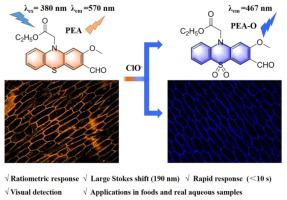基于吩噻嗪的次氯酸盐(ClO -)比例荧光探针及其在食品和水样中的应用
IF 9.8
1区 农林科学
Q1 CHEMISTRY, APPLIED
引用次数: 0
摘要
作为一种重要的活性氧(ROS), ClO−在日常生活和许多生物事件中发挥着广泛的作用。然而,它的异常水平对人体健康造成严重危害。因此,开发有效的方法来检测食品和生物体内的氯离子是至关重要的。在这项工作中,提出了一种新的荧光探针2-(3-甲酰基-2-甲氧基- 10h -吩噻嗪-10-基)乙酸乙酯(PEA)检测氯离子。它具有快速的比率响应(在10 s内)、高选择性和非常大的Stokes位移(190 nm)的优点。PEA对ClO−的检出限为0.47 μM。我们不仅成功制备了高效定性肉眼检测ClO -的试纸条,而且还证明了其在天然水样、饮料和食品中有效检测ClO -的潜力。此外,还将探针PEA应用于洋葱表皮细胞中ClO−的荧光成像。本文章由计算机程序翻译,如有差异,请以英文原文为准。


A phenothiazine-based ratiometric fluorescent probe for detecting hypochlorite (ClO−) and its application in foods and water samples
As a significant reactive oxygen species (ROS), ClO− plays versatile roles in daily life and many biological events. However, its abnormal levels are responsible for serious harm to human health. Therefore, it is of crucial interest to develop effective methods for detecting ClO− in foods and living organisms. In this work, a novel fluorescent probe ethyl 2-(3-formyl-2-methoxy-10H-phenothiazin-10-yl)acetate (PEA) for detecting ClO− was presented. It shows the merits of rapid ratiometric response (within 10 s), high selectivity and very large Stokes shift (190 nm). The detection limit of PEA for ClO− was determined to be 0.47 μM. We not only successfully prepared paper test strips for efficient qualitative naked eye ClO− detection, but also demonstrated its potential for the valid detection of ClO− in natural water samples, beverages and foods. Furthermore, the probe PEA was also applied to the fluorescence imaging of ClO− in onion epidermal cells.
求助全文
通过发布文献求助,成功后即可免费获取论文全文。
去求助
来源期刊

Food Chemistry
工程技术-食品科技
CiteScore
16.30
自引率
10.20%
发文量
3130
审稿时长
122 days
期刊介绍:
Food Chemistry publishes original research papers dealing with the advancement of the chemistry and biochemistry of foods or the analytical methods/ approach used. All papers should focus on the novelty of the research carried out.
 求助内容:
求助内容: 应助结果提醒方式:
应助结果提醒方式:


